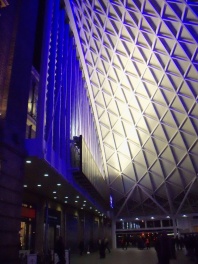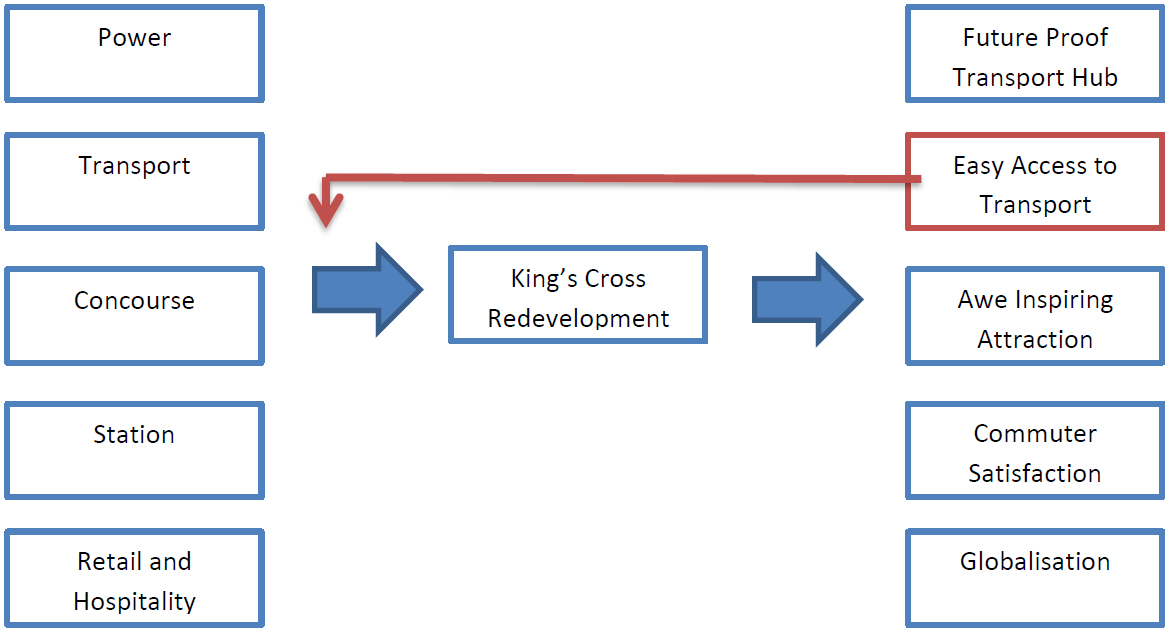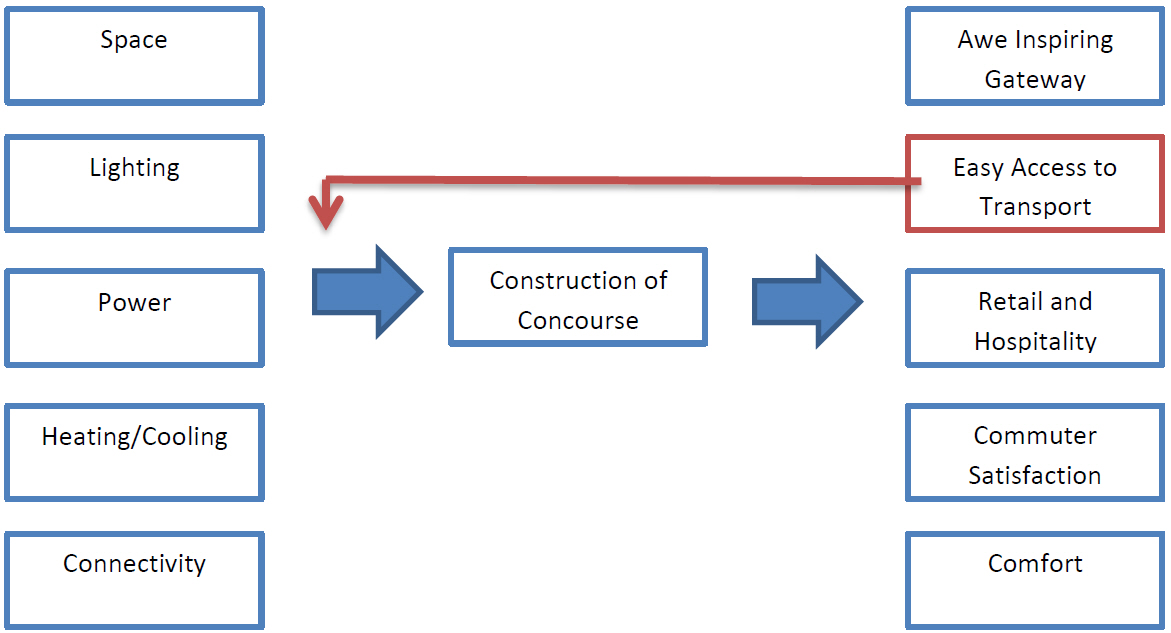King's Cross Station Redevelopment
Contents |
[edit] Introduction
King's Cross station was designed by Lewis Cubitt in 1852 and was the largest single-span structure in Europe. The roof is 105ft wide by 800ft long and was originally supported by laminated timber. However, this was subsequently replaced by steel. (Durant, 2010)
Almost 40 million passengers use King's Cross every year and this number is likely to increase. Redevelopment of the station was announced in 2005. The £400m Plans included restoration of the existing grade I listed building, incorporation of the King's Cross St Pancreas London underground station and a new station concourse that would create an inspiring new entrance to the city. (Arup, 2012)
In 2006, planning permission was granted to redevelop the station and regenerate the surrounding areas, totaling some 8 million sq. ft. The development includes a variety of uses such as a new University and a large amount of public space straddling Regent's Canal. Arguably, this regeneration will create one of the most significant changes to London in 300 years. (Littlefield, 2012) (King's Cross Central Limited Partnership, 2012). This part of the project is expected to continue beyond 2020 and many of the details are still unknown.
The core challenge of the project was to bring the station into the 21st century and provide a futue-proof transport hub suitable for an ever growing city, whilst retaining the original features of the grade I listed building.
[edit] Constraints
There were a number of constraints to the way the development:
- It was decided that an essential aim of the project would be to have the vast majority of infrastructure in place for the London Olympics in 2012. It was anticipated that during the Olympics there would be an even greater number of people in the city, and increased pressure on the transport network. The Olympics also provided an opportunity to showcase the development to the world. This meant that the project had to be completed within five years, whilst minimising disruption to the existing station and transport network.
- There were significant environmental concerns relating in particular to carbon emissions and waste generation.
- King's Cross is a grade I listed building, meaning that it cannot be unjustly altered or demolished and that features of the building must be retained for heritage purposes.
- Economic constraints, particularly given the economic conditions at the time when the development was underway.
- Social responsibilities such as keeping the disruption of existing services to a minimum and consulting with community stakeholders.
- The health and safety of the workforce and general public.
- Transparency and the provision of publicly available information
[edit] Parties and Disciplines Involved
- John McAslan + Partners were the architects for the project (Arup, 2012)
- Network Rail Ltd was the client for the redevelopment of King's Cross station.
- King's Cross is being developed by the King's Cross Central Limited Partnership which brings together three groups; Argent King's Cross Limited Partnership, London & Continental Railways Limited (LCR) and DHL Supply Chain. (King's Cross Central Limited Partnership, 2012)
- Arup was the lead consultant on the project. They provided transport planning, multi-disciplinary engineering services, security, IT, lighting design, acoustics, visualisation and pedestrian modelling. (Arup, 2012)
- A number of contractors were used during the construction phase of the project; Companies included Carillion, BAM Nuttall, BAM Construct and Kier group. (King's Cross Central Limited Partnership, 2012).
- In order to ensure that the obligations of the redevelopment of King's Cross were met, Network Rail appointed Turner & Townsend to provide an overarching commercial management service. Turner & Townsend set up an experienced management team which took charge of procurement and cash flow. As well as this, Turner & Townsend supported Network Rails own project management team when dealing with other aspects of the project such as the environment. (Turner& Townsend plc , 2011) The appointment of this third party company to provide project management is an example of a multi stake holder approach which promotes democracy, transparency and accountability.
The redevelopment of King's Cross was a huge project and incorporated many aspects of civil engineering including project planning, transport planning and pedestrian modelling as provided by Arup. As well as this, geotechnical engineering was involved in the incorporation of the underground aspects of the existing transport network in London. Lighting design and acoustics were also vital and mechanical and electrical engineering services were needed to provide energy, information and connectivity.
[edit] Analysis of the Project
As a system the project can be broken down into a number of different elements and sub elements.
Figure 1; overall system
Figure 2; concourse sub-element
[edit] Conclusion
As the project is still on-going, it is difficult to gauge how well it has achieved its goals.
The core challenge of the project was to bring an ageing station into the 21st century and to provide a future proof transport hub, whilst retaining the original features of the building. The project was also required to be complete for the London Olympics whilst limiting disruption to existing services. These goals have been achieved. The new station and concourse was open months in advance of the Olympics and Network Rail claim that not one single train was cancelled during construction (Network Rail, 2012). The new concourse seamlessly incorporates the heritage of King's Cross into an awe inspiring entrance to an improving and expanding city.
[edit] Related articles on Designing Buildings
- 22 Bishopsgate.
- A heritage partnership agreement for King's Cross Station.
- Barking Riverside development landscape.
- Battersea Arts Centre.
- Battersea Power Station.
- Brownfield land.
- Community group.
- Crossrail 2.
- Digital 21st century - Ramboll.
- Dust heap.
- Enterprise zones.
- Health and wellbeing at Kings Cross.
- Heathrow Terminal 5.
- Hertsmere House project.
- London 2012 Olympic Stadium.
- Millennium Mills.
- Mixed use development.
- Old Buildings, New Architecture.
- Planning permission.
- Railway stations.
- Regeneration.
- Thames barrier.
- Wembley Park.
[edit] External references
- Arup, 2012. Fast Facts. [Accessed 11 12 2012].
- Arup, 2012. Kings Cross Station. [Accessed 06 12 2012].
- Ashley, R., 2012. The role of the civil engineer in society: engineering ethics and major projects. ICE Civil Engineering , 165(CE3), p. 99.
- Doherty, A., Dora, J. & Newsome, C., 2012. Enhancing Britains Railway Infrastructure. Civil Engineerings Special Issue, 165(CE6), pp. 20-26.
- Durant, S., 2010. Victorian Railway Stations. [Accessed 06 12 2012].
- Hawkins, J. & McKittrick, B., 2012. Construction Sector Transparency Initiative: making construction more accountable. ICE Civil Engineering Proceedings, 165(CE2), pp. 82-88.
- Holgersen, S. & Haarstad, H., 2009. Class, Community and Communicative Planning: Urban Redevelopment at Kings Cross London. Antipode, 41(2), pp. 348-370.
- King's Cross Central Limited Partnership, 2012. The Development. [Accessed 07 12 2012].
- King's Cross Central Limited Partnership, 2012. Who's Developing King's Cross. [Accessed 11 12 2012].
- Littlefield, D., 2012. London (Re) Generation. Architectural Design, 82(1), pp. 32-35.
- Rostron, J., 2001. Environmental Law for the Built Environment. 1st ed. London: Cavendish Publishing.
- Turner& Townsend plc , 2011. Network Rail - King's Cross Station redevelopment programme. [Accessed 07 12 2012].
Featured articles and news
The UK's Modern Industrial Strategy: A 10 year plan
Previous consultation criticism, current key elements and general support with some persisting reservations.
Building Safety Regulator reforms
New roles, new staff and a new fast track service pave the way for a single construction regulator.
Architectural Technologist CPDs and Communications
CIAT CPD… and how you can do it!
Cooling centres and cool spaces
Managing extreme heat in cities by directing the public to places for heat stress relief and water sources.
Winter gardens: A brief history and warm variations
Extending the season with glass in different forms and terms.
Restoring Great Yarmouth's Winter Gardens
Transforming one of the least sustainable constructions imaginable.
Construction Skills Mission Board launch sector drive
Newly formed government and industry collaboration set strategy for recruiting an additional 100,000 construction workers a year.
New Architects Code comes into effect in September 2025
ARB Architects Code of Conduct and Practice available with ongoing consultation regarding guidance.
Welsh Skills Body (Medr) launches ambitious plan
The new skills body brings together funding and regulation of tertiary education and research for the devolved nation.
Paul Gandy FCIOB announced as next CIOB President
Former Tilbury Douglas CEO takes helm.
UK Infrastructure: A 10 Year Strategy. In brief with reactions
With the National Infrastructure and Service Transformation Authority (NISTA).
Ebenezer Howard: inventor of the garden city. Book review.
The Grenfell Tower fire, eight years on
A time to pause and reflect as Dubai tower block fire reported just before anniversary.
Airtightness Topic Guide BSRIA TG 27/2025
Explaining the basics of airtightness, what it is, why it's important, when it's required and how it's carried out.
Construction contract awards hit lowest point of 2025
Plummeting for second consecutive month, intensifying concerns for housing and infrastructure goals.
Understanding Mental Health in the Built Environment 2025
Examining the state of mental health in construction, shedding light on levels of stress, anxiety and depression.
























